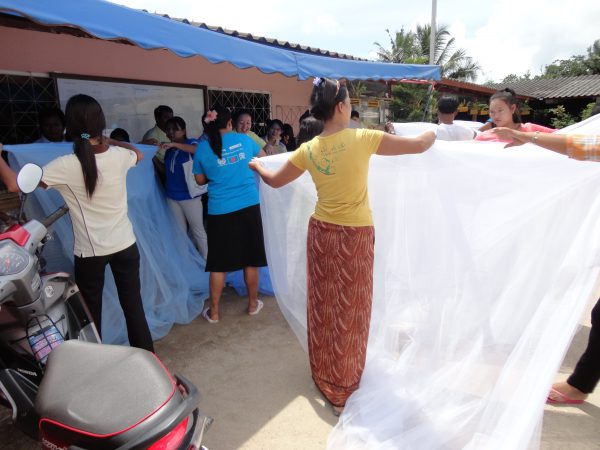The PMI-supported Control and Prevention of Malaria (CAP-Malaria) project works to contain the spread of multi-drug resistant malaria in the Mekong Subregion.
In Cambodia, malaria is concentrated in the remote and forested border areas; from there, it spreads to other parts of Cambodia or neighboring countries due to population movements. Western Cambodia, along the border with Thailand, is an area of particular concern with its rubber plantations and large farms that attract migrant laborers. Many of these workers are especially vulnerable to malaria as they have low immunity to the disease and little knowledge about how to prevent malaria and recognize its symptoms. As a result, they are more likely to contract malaria and less likely to seek treatment. In addition, when they return to their permanent residence, they can carry the parasites back to their families, which further perpetuates the cycle of malaria transmission.
The PMI-supported Control and Prevention of Malaria (CAP-Malaria) project works to contain the spread of multi-drug resistant malaria in the Mekong Subregion. One of its strategies is to increase to use of long-lasting insecticide-treated mosquito nets (ITNs) to prevent mosquito bites. The conventional strategies to distribute long-lasting ITNs include distributions through health centers or during community campaigns. These approaches, however, do not reach migrant workers who are only temporarily residing in the area.
To increase access to ITNs for this transient population, the project developed a model to lend nets to migrant workers through their employers — farm owners or companies. The project provides the nets to the employer, who in turn lends them to the migrant worker for the season. At the end of the migrant worker’s contract, he returns the net to his employer who lends it once again to other employees during the next season. The model, currently being implemented in ten districts, has resulted in the distribution of over 185,000 long-lasting ITNs to over 9,000 farm owners/companies in 325 malaria-endemic villages.
Feedback from community leaders and farm owners has been positive. Rea Reay is a farm owner who received 15 nets for her 15 migrant workers in Borya Kha village in the Pailin District, one of the areas with the largest malaria burden and where artemisinin-resistant malaria has been found. She is enthusiastic about the benefits of the lending scheme and says: “Since I have nets from the scheme, I do not buy them from the market anymore…and when I loaned them to the workers, they said they wanted to come to work here again because they could receive free nets to protect them from malaria.” Her opinion is echoed by Mr. Leum Sambo, the commune leader for Bor Yakha, who said, “Lending long-lasting ITNs to mobile and migrant workers is very important in my commune because the workers are poor and cannot afford to buy nets; it benefits both the farm owners and workers.” Mr. Sambo has observed that since migrant workers now have access to nets, there is less malaria infection in the village, “Since long-lasting ITNs are available everywhere, I rarely see people sick with malaria, unlike several years ago.”
Innovative and creative solutions, such as the ITN lending scheme, are needed to ensure that all persons at risk for malaria, including mobile and migrant populations, are protected against malaria. While this project was confined to Cambodia, the model may be of interest for malaria control efforts among migrant populations in other settings.

